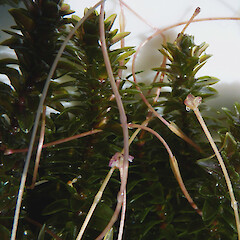Elodea canadensis
Common name
Canadian pondweed
Family
Hydrocharitaceae
Flora category
Vascular – Exotic
Structural class
Herbs - Monocots
NVS code
The National Vegetation Survey (NVS) Databank is a physical archive and electronic databank containing records of over 94,000 vegetation survey plots - including data from over 19,000 permanent plots. NVS maintains a standard set of species code abbreviations that correspond to standard scientific plant names from the Ngä Tipu o Aotearoa - New Zealand Plants database.
ELOCAN
Conservation status
Not applicable
Brief description
Submerged, bottom rooted perennial aquatic plant in the oxygenweed group, that grows in both still and flowing waters. The stems are brittle and pale with bright green leaves occurring in whorls of three, and often with little space between each whorl. Flowers are inconspicuous.
Distribution
Widely naturalised through the North and South Islands.
Habitat
Aquatic: a submerged plant in moderately fast flowing to still water bodies.
Wetland plant indicator status rating
Information derived from the revised national wetland plant list prepared to assist councils in delineating and monitoring wetlands (Clarkson et al., 2021 Manaaki Whenua – Landcare Research Contract Report LC3975 for Hawke’s Bay Regional Council). The national plant list categorises plants by the extent to which they are found in wetlands and not ‘drylands’. The indicator status ratings are OBL (obligate wetland), FACW (facultative wetland), FAC (facultative), FACU (facultative upland), and UPL (obligate upland). If you have suggestions for the Wetland Indicator Status Rating, please contact: [Enable JavaScript to view protected content]
OBL: Obligate Wetland
Almost always is a hydrophyte, rarely in uplands (non-wetlands).
Detailed description
Submerged, bottom-rooting perennial, growing to 8+ m. Stems slender, brittle, branched, 1 mm diameter leaves in whorls of 3 (opposite at base), linear, 6-12 x 2 mm, translucent dark green. Male (very rare) and female flowers on separate plants. Flowers on surface, on long thread-like stalks, 5-petalled, 5 mm diam, white, tinged purple. No seed set in NZ.
Similar taxa
Egeria (Egeria densa) and lagarosiphon (Lagarosiphon major). Canadian pondweed is much smaller than egeria and almost always has leaves arranged in whorls of 3 compared with egeria which is usually in whorls of at least 4. Lagarosiphon has leaves that curl downwards and are arranged in spirals around the stem (not whorls).
Flowering
November, December, January
Flower colours
Violet/Purple
Fruiting
No fruit seen in NZ
Life cycle
Reproduces by vegetative fragmentation from stem material and dispersed within catchments via water flow. New catchments invaded by contaminated boats and trailers (occasionally motor cooling water), eel nets, diggers, people liberating fish, floods from ornamental ponds. Sold in the aquarium trade.
Year naturalised
1872
Origin
North America.
Reason for introduction
Ornamental aquarium plant.
Control techniques
Can be controlled manually, mechanically or herbicidally depending on situation.
Tolerances
Tolerant of water temperatures up to 28 degrees C. Requires moderate to high light.
Etymology
elodea: From the Greek elodes ‘marsh’
canadensis: Of Canada
Attribution
Factsheet prepared by Paul Champion and Deborah Hofstra (NIWA).
References and further reading
Champion et al (2012). Freshwater Pests of New Zealand. NIWA publication. http://www.niwa.co.nz/freshwater-and-estuaries/management-tools/identification-guides-and-fact-sheets/freshwater-pest-species.
Coffey BT, Clayton JS (1988). New Zealand water plants: a guide to plants found in New Zealand freshwaters. Ruakura Agricultural Cente. 65pp.
Johnson PN, Brooke PA (1989). Wetland plants in New Zealand. DSIR Field Guide, DSIR Publishing, Wellington. 319pp.
Popay et al (2010). An illustrated guide to common weeds of New Zealand, third edition. NZ Plant Protection Society Inc, 416pp.






